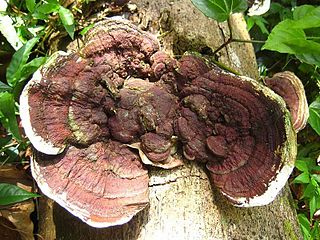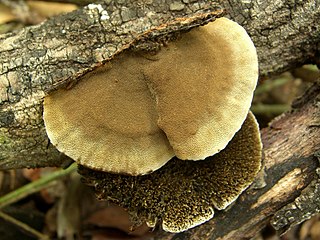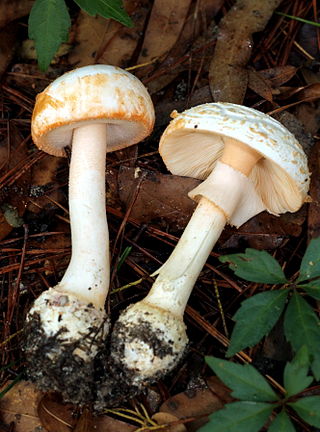
The Polyporaceae are a family of poroid fungi belonging to the Basidiomycota. The flesh of their fruit bodies varies from soft to very tough. Most members of this family have their hymenium in vertical pores on the underside of the caps, but some of them have gills or gill-like structures. Many species are brackets, but others have a definite stipe – for example, Polyporus badius.

William Alphonso Murrill was an American mycologist, known for his contributions to the knowledge of the Agaricales and Polyporaceae. In 1904, he became the assistant Curator at the New York Botanical Garden (NYBG). He, along with the NYBG, founded the journal Mycologia and was its first editor for 16 years. Murrill was known to travel extensively to describe the mycota of Europe and the Americas. He traveled along the East Coast, Pacific Coast, Mexico and the Caribbean. Although Murrill was a very influential person at the NYBG, having worked his way up to become assistant director in 1908, his rather eccentric personality caused problems with his job. He went on annual collecting trips to Mexico, the Caribbean, Europe, and South America, sometimes, without informing any of his colleagues prior. These trips resulted in a cumulative total of 70,000 specimens, 1,400 of which are deposited in the NYBG.
Herbert Henry John Murrill was an English musician, composer, and organist.

Irpex lacteus is a common crust fungus distributed throughout temperate areas of the world. It is the type of the genus Irpex. Irpex lacteus is considered a polypore, but depending on growth conditions it can also produce a hydnoid hymenophore. Due to this variability and abundance of the species it has been described as a new species to science numerous times and subsequently has an extensive synonymy. The complete genome sequence of Irpex lacteus was reported in 2017.

Rigidoporus is a genus of fungi in the family Meripilaceae. Many of the species in this genus are plant pathogens. The widespread genus, which contains about forty species, was originally circumscribed by American mycologist William Alphonso Murrill in 1905. The generic name combines the Latin word rigidus ("rigid") with the Ancient Greek word πόρος ("pore").

Lentinus is a genus of fungi in the family Polyporaceae. The genus is widely distributed, with many species found in subtropical regions.

Xerocomellus zelleri, commonly known as Zeller's bolete, is an edible species of mushroom in the family Boletaceae. First described scientifically by American mycologist William Alphonso Murrill in 1912, the species has been juggled by various authors to several genera, including Boletus, Boletellus, and Xerocomus. Found solely in western North America from British Columbia south to Mexico, the fruit bodies are distinguished by their dark reddish brown to nearly black caps with uneven surfaces, the yellow pores on the underside of the caps, and the red-streaked yellow stems. The fungus grows in summer and autumn on the ground, often in Douglas fir forests or on their margins. The development of the fruit bodies is gymnocarpic, meaning that the hymenium appears and develops to maturity in an exposed state, not enclosed by any protective membrane.

Bjerkandera is a genus of wood-rotting fungi in the family Meruliaceae.

Coriolopsis is a genus of fungi in the family Polyporaceae. It was circumscribed by American mycologist William Alphonso Murrill in 1905. The genus is cosmopolitan, with most species in tropical areas. The generic name combines the name Coriolus with the Ancient Greek word ὄψις ("appearance").

Earliella is a fungal genus in the family Polyporaceae. It is a monotypic genus, containing the single species Earliella scabrosa. It is found in Hainan.

Hexagonia is a genus of poroid fungi in the family Polyporaceae. The genus has a widespread distribution, especially in tropical regions. The generic name is derived from the Latin word hexagonus, meaning "with six angles".

Nigroporus is a genus of poroid fungi in the family Steccherinaceae. The genus was circumscribed by American mycologist William Alphonso Murrill in 1905. Nigroporus has a pantropical distribution. The genus name combines the Latin word niger ("black") with the Ancient Greek word πόρος ("pore").

Tyromyces is a genus of poroid fungi in the family Polyporaceae. It was circumscribed by mycologist Petter Karsten in 1881. The type species is the widely distributed Tyromyces chioneus, commonly known as the white cheese polypore. The phylogenetic position of Tyromyces within the Polyporales is uncertain, but it appears that it does not belong to the "core polyporoid clade". Tyromyces is polyphyletic as it is currently circumscribed, and has been described as "a dumping place for monomitic white-rot species with thin-walled spores."
Gertrude Simmons Burlingham was an early 20th-century mycologist best known for her work on American Russula and Lactarius and pioneering the use of microscopic spore features and iodine staining for species identification.

Amanita roseotincta is a species of agaric fungus in the family Amanitaceae found in North America. It was first described by American mycologist William Alphonso Murrill in 1914 as a species of Venenarius before being transferred to Amanita the same year.

Fuscoporia is a genus of polypore fungi in the family Hymenochaetaceae. It was circumscribed by American mycologist William Alphonso Murrill in 1907.

The 2023 Louisiana Attorney General election was held on November 18, 2023 to elect the next attorney general of Louisiana, with the first round occurring on October 14. Incumbent Republican Attorney General Jeff Landry retired to successfully run for governor, leading to an open race. In the runoff, Louisiana Solicitor General Liz Murrill defeated attorney Lindsey Cheek by a margin of 33 percent.















